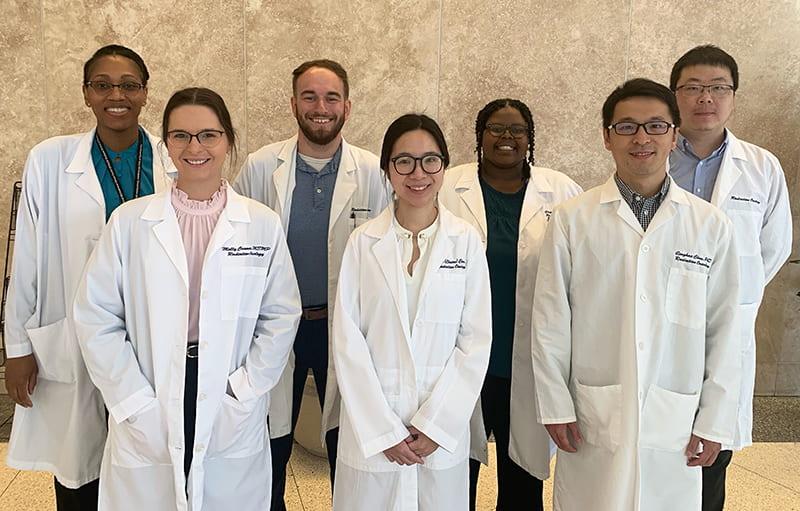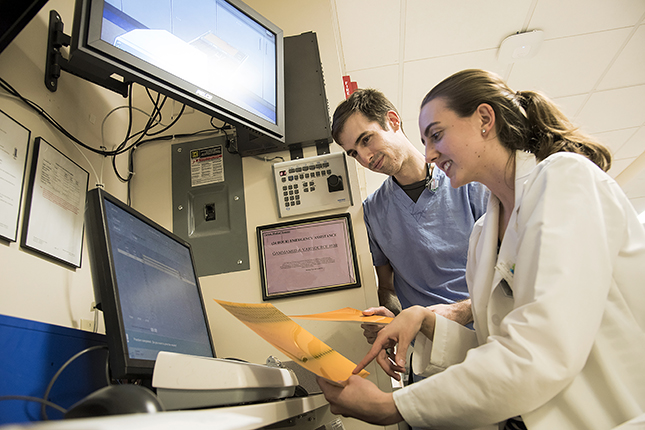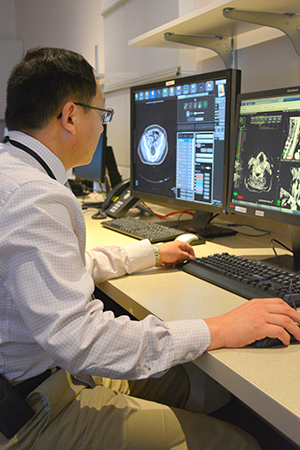The length of the residency education program is two years and the training calendar starts on January 1 or July 1 of each year. During the second year of residency, there is one month allocated for either clinical research and special rotation, or “catch-up.” Clinical research projects and special rotations must be approved by the Program Director. A resident who is struggling will use the month for “catch-up,” i.e. an additional rotation.
Training program review is an ongoing task and the responsibility of the Program Director and the Physics Residency Committee. The training essentials and clinical physics rotations are generally reviewed once a year. If changes are needed to meet the needs of the Program, then the Physics Residency Program Director targets the appropriate faculty for that task. Modifications require submission by the faculty to and subsequent approval by the Physics Residency Committee and/or Program Director.
Examples of past clinical rotation assignments, reports, lecture handouts, and examinations are available for review. Resident evaluations of clinical rotations are discussed in regularly scheduled meetings held with the resident.

During the first year, the physics resident attends didactic lectures, special training sessions, conferences, and participates directly in the clinic through a series of treatment planning, special procedures, and brachytherapy rotations. The resident works closely with staff physicists and dosimetrists to observe and participate in conventional and IMRT treatment planning, image acquisition, on-board imaging CBCT, fusion, registration, image guidance, dose calculations, design and fabrication of patient treatment aids, and special bolus; treatment machine calibrations; patient and phantom dose measurements, quality assurance procedures, brachytherapy procedures, and other physical and technical tasks performed in the clinic. During this time, the resident should develop basic radiation oncology physics skills and also should develop an overall understanding of the radiation oncology physicist’s and dosimetrist’s role in the clinic.
New resident orientation
New physics residents are provided a one day orientation lecture series followed by a 3-day rotation in the CT simulators and accelerators at the beginning of their training. This is followed by an intense 10-day course on fundamentals of treatment planning. In addition, the Program Director and Physics Faculty meet with each new resident at that time to ensure the incoming resident clearly understands the program’s requirements, resident administrative procedures, and any other expectations. At this meeting, the resident is made aware of staff and program resources, including treatment machines, treatment planning facilities, laboratories and libraries. Each faculty member gives advice and expectations of the resident.
Clinical rotations
The clinical rotations are the core element of the 1st year of residency training. They have 4 core elements to them; a) the actual assigned rotation, b) the assigned readings, c) assigned comprehensions with assigned faculty, and d) testing.
For each rotation, there are particular training essentials that include references. The training essentials may or may not include a check-off list of mastered tasks, depending on the rotation.
There are mandatory minimal readings that are assigned for each rotation, additional suggested readings as part of the comprehensions and training essentials.
Radiation safety
Incoming residents are required to pass a radiation safety exam within the first month of beginning the program. A safety guide is included with orientation material. In addition, the Washington University Radiation Safety Office provides an annual refresher lecture which all staff and residents are required to attend.
All first year residents are issued a radiation monitor by WU as part of their new employee procedure.
All residents attend orientation lectures on treatment machine operation and introductory training in the dangers of high voltage.
During the course of the first year, Physics Residents attend a lecture intended to make them aware of potential hazards due to chemicals or bio-hazardous materials. Residents also attend required safety training provided by the University/Hospital, including fire safety.
Comprehensions and exams
The comprehensions are intended to foster faculty-resident interaction, and to ensure the resident understands the background and details. The comprehensions are assigned coinciding with the rotations. Resident and the assigned faculty meet 3-4 times in the scheduled month to discuss the particular subject. Additional meetings can be scheduled if the resident is struggling.
At the close of most rotations, there is a short exam that covers the rotation and the comprehension. This is conducted by 2 faculty members and the resident. If the faculty feels additional studying and reading is necessary, the resident will do so and retake the rotation based exam.
At the beginning of the second year, the successful physics resident is given more responsibility (but always under the direct supervision of a physics faculty member). During the second year, the resident should develop confidence and continue the development of the necessary skills and experience to be prepared for independent clinical physics practice.
In the second year, the specific rotations also end with a short exam based on the rotation. Additional readings are typically assigned, especially if the resident does not pass the rotation based exam.
First-year rotations
Orientation: 1 month
Conventional TP: 2 months
IMRT (Pinnacle, Eclipse): 4 months
Brachytherapy: 3 months
Patient QA & Special Procedures: 2 months
Second-year rotations
July – Sept: External Beam Concentration
Oct – Nov: IMRT Concentration
Dec: MR Guided RT
Jan: Developmental
Feb – Mar: Brachytherapy Concentration
Apr: Imaging/Localization
May: ESRT/SRS
June: Protons

Requirements for program completion
In order to complete the Physics Residency Program, the Physics Resident must:
- Successfully complete the clinical rotations listed below:
- Conventional Treatment Planning
- IMRT (Pinnacle, Eclipse)
- Brachytherapy
- Patient QA & Special Procedures
- External Beam Concentration
- IMRT Concentration
- MR-Guided RT
- Developmental
- Brachytherapy Concentration
- Imaging/Localization
- ESRT/SRS
- Protons
- Pass the special training sessions and didactic courses listed below:
- Orientation (first 2 weeks of 1st year)
- 10 day course on planning
- Radiation Safety Exam (within 30 days beginning 1st year)
- Physics Didactic Course (Aug-Mar. during 1st year)
- Annual Radiation Safety on-line training (presentation by WU Radiation Safety once a year)
- Participate in/attend the conferences and special lectures listed below:
- Academic Update Conference (every Friday 8-9:00 am for 2 years)
- Patient Management Conference (Monday, Tuesday, Wednesday for 2 years)
- Current Case Review Conference (every Tuesday 7:30-8:30 am for 2 years)
- Morbidity & Mortality conference (one Thursday a month 12:00-1:00 pm for 2 years)
- New Topic Conference (every Thursday 12:00-1:00 pm for 2 years)
- Resident Lecture (MD) Education Course (each Thursday 7:30-8:30 am for 2 years)
- Physics Resident Seminars (resident presentation once a month Sept.-June for 2 years).
- Physician Resident Physics Seminars (once a month for 2 years)
- Machine Operation and Safety Orientation (during 1st month)
- Annual Fire, Chemical, Biohazard on-line training (yearly presentation by Environmental Safety)
- Prepare handouts for 3 assigned topics for presentation at Physics Resident Seminar
- 12 Site Reports (8 clinical external beam, 2 brachytherapy, 2 delivery systems)
- Pass end-of-rotation exams (3 in 1st year, 2 in 2nd year)
- Completion of comprehensions (1 per month in 1st year)
- Pass Year 1 Oral Exam
- Pass Year 2 Oral Exam
Evaluation of resident progress
Residents are monitored through the program by the assigned faculty for each clinical rotation. Meetings every six weeks between the physics resident, Program Director, and assigned faculty for the current rotation are meant to discuss problems related to resident training. This meeting also gives an opportunity for the resident to provide feedback about the program. A formal evaluation is performed by the resident upon completion. At this meeting, the resident’s progress in their current rotation is reviewed, discussed, and if needed altered. Near the end of each year of their training, the resident is given an oral examination. If the resident does not pass the exam, the resident is placed on probation. During that period, the resident is assigned to the area(s) of demonstrated weakness. At the end of the probation period, an oral exam is again conducted. If the resident does not pass this second oral exam, the resident is terminated from the Residency Program. This occurs under the procedures and guidelines of Washington University.

By the end of the first year, the Physics Resident is expected to function as a Junior Physicist, with the ability to perform quality assurance tests, patient QA, monitor unit and dose calculations, conventional and IMRT treatment planning, radiation safety procedures, and brachytherapy physics procedures and planning. By the completion of the two year term, the physics resident is expected to be able to perform all radiation oncology physics functions, including full calibrations of treatment machines, checks of dosimetry work (treatment plans, etc.), weekly paper and electronic chart reviews including delivery and imaging for patients, radiation safety procedures, clinical consultations, and patient-related dosimetry. Every effort is made to include as many residents as possible into commissioning and acceptance testing of simulation, delivery, and localization systems.